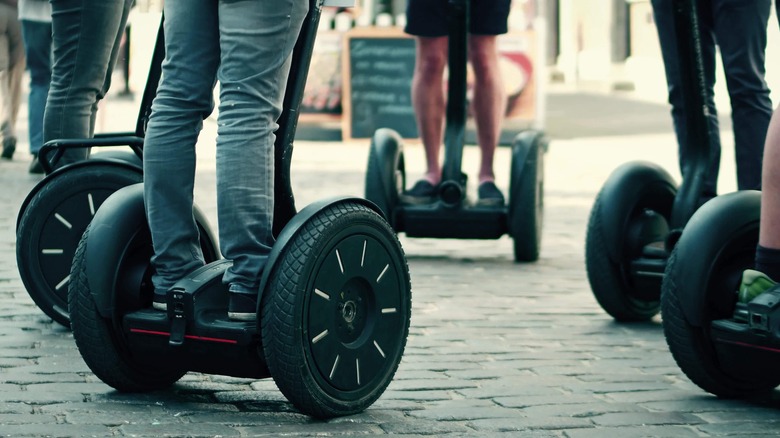The Real Reason The Segway Was A Failure
Was it ahead of its time, or just too goofy to survive? The Segway roared (figuratively speaking) onto city sidewalks in the early 2000s, but it didn't take off as expected. Like Google Glass, "hoverboards," and other 21st-century inventions that nobody asked for, the Segway has largely gone the way of the buffalo, a joke reserved for movies like the 2009 Kevin James film "Paul Blart: Mall Cop."
Even before it came out, the Segway had some naysayers among the heavy hitters of the high tech industry. Wired reports that Amazon founder Jeff Bezos called the product "dead on arrival," accurately pointing to the real world problems of using it on the street. Where? The sidewalk, the bike lane, the road? Neither was Apple legend Steve Jobs on board with the device that was just reclining one seat away from turning us all into characters from Wall-E. He reportedly told the scooter's inventor Dean Kamen that all it would take was a rider to fall and sustain an injury for the whole project to come crashing down. Then three high-profile riders went on to prove him exactly right. Let's take a look at what happened.
Three tragic high-profile Segway accidents
In 2003, the year after the Segway was put on the market, President George W. Bush was photographed (above) falling off of one of the machines while on vacation in Maine. The leader of the free world taking a tumble on your silly scooter is not good PR. Then a few years later, in 2007, the British TV personality who likes to call himself a journalist Piers Morgan biffed it on a Segway and broke three ribs.
The most tragic — and ironic — of the three celebrity Segway accidents occurred in 2010. According to The New York Times, British businessman James W. Heselden had bought Segway — not a scooter, the whole company — early that year. In September, he was riding one on his estate when he accidentally rode the thing off of a 30-foot cliff and into the river below. Heselden, 62, died as a result of the fall.
While being tragically unsafe surely played a role in the cataclysmic failure that was the Segway (Kamen expected it to revolutionize urban transportation and planning), the device's downfall was ultimately caused by its intrinsic silliness. Riders reported being called lazy by people using their good old fashioned feet to get around. Revolutionary as the technology was, it was no match for people's sense of taste and common sense, and fortunately our city streets aren't swarming with the awkward vehicles two decades later.

